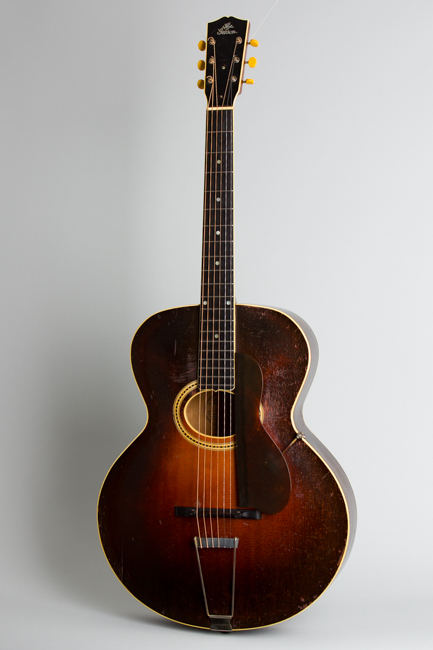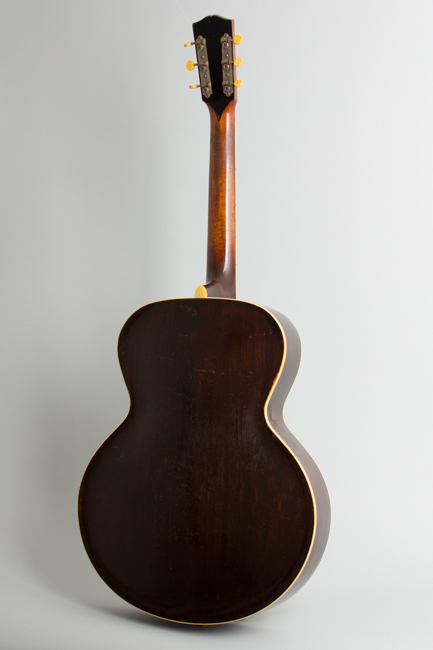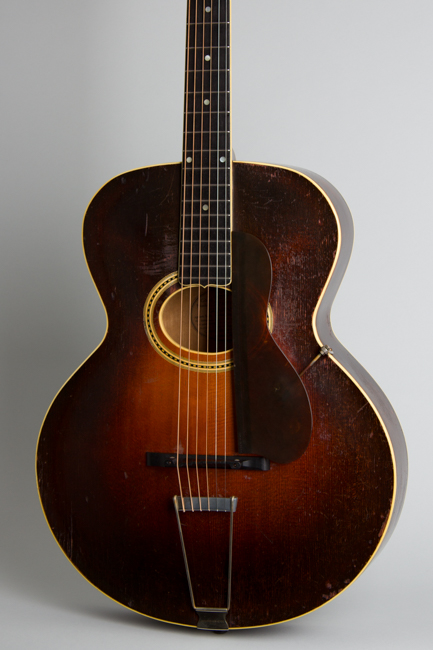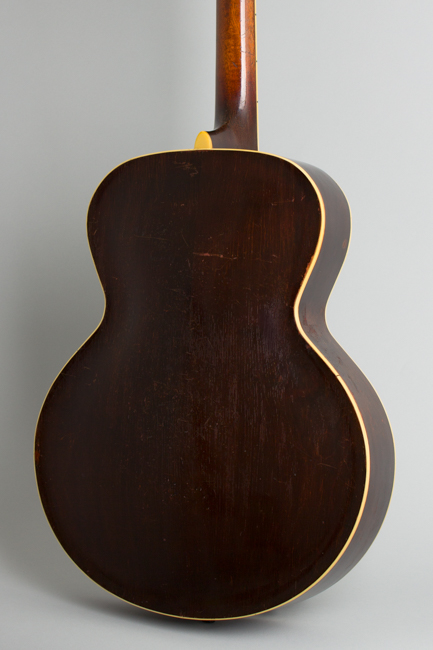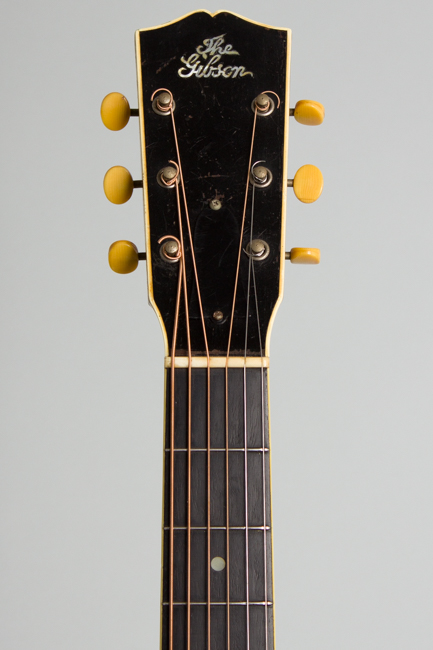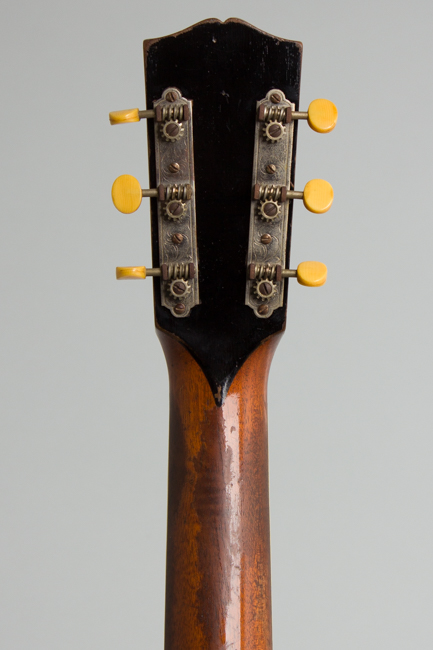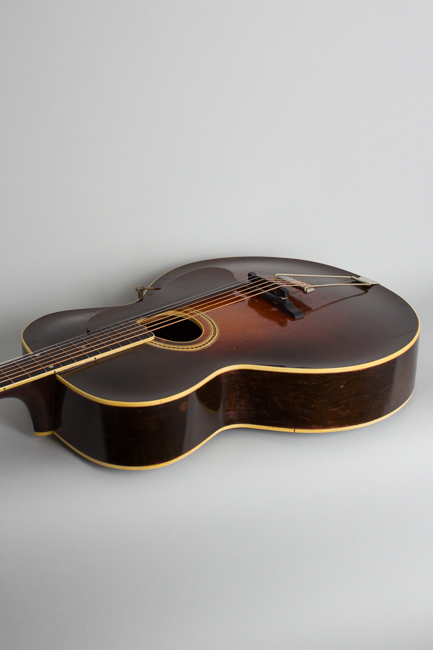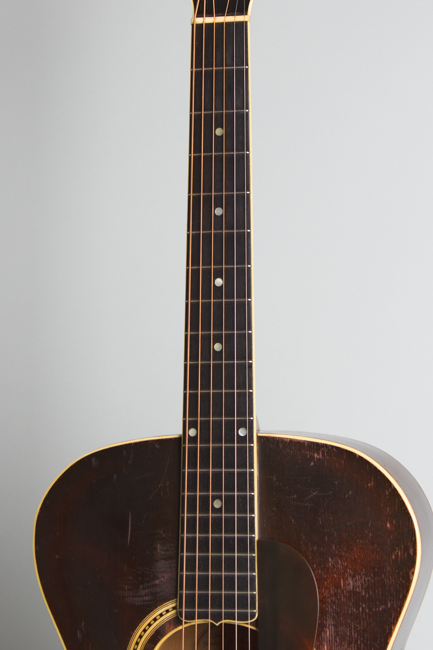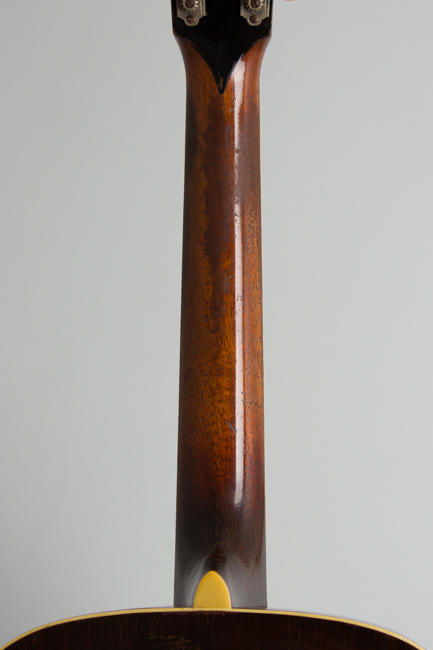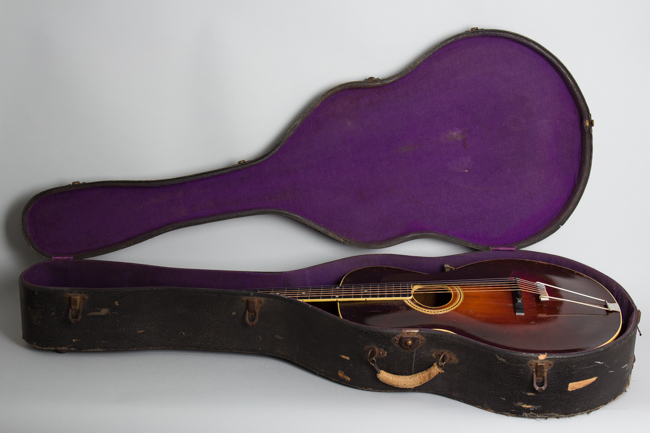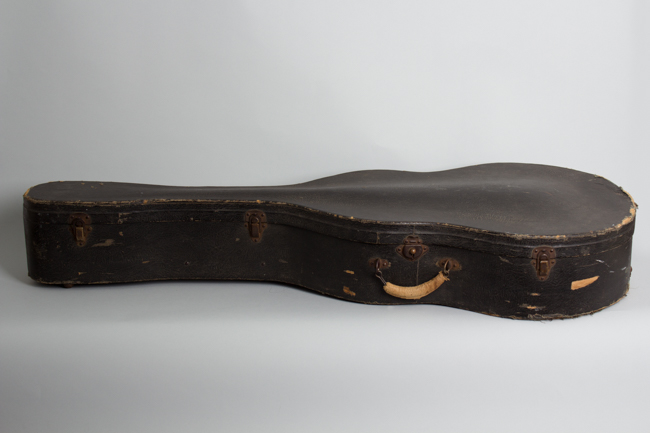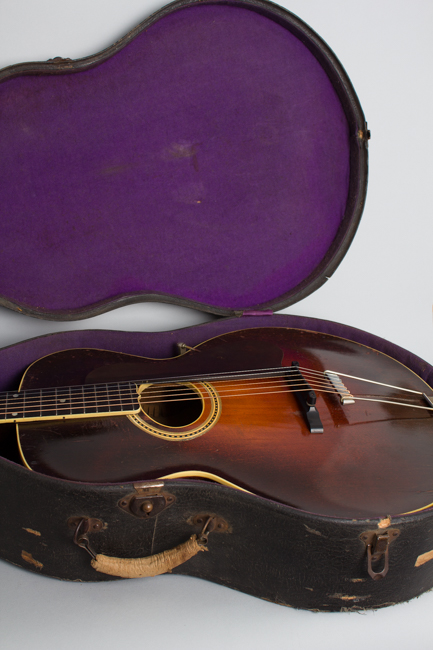Gibson L-4 Arch Top Acoustic Guitar (1931)
This item has been sold.
Item # 11114
Prices subject to change without notice.
Gibson L-4 Model Arch Top Acoustic Guitar (1931), made in Kalamazoo, Michigan, serial # 87630, sunburst top, dark stained back and sides finish, birch back and sides, spruce top; mahogany neck with ebony fingergoard, original black hard shell case.
This is a very interesting, fairly rare, and surprisingly good sounding guitar: an oval-soundhole L-4 from the final period of this original design for the model. This example was made in early-mid 1931, and is similar to the earlier 1920's L-4s but with a much more comfortable wide round-backed neck in place of the earlier "V" style. It has all the new features introduced by Gibson in the 1920's including the adjustable ebony bridge, adjustable truss rod neck and solid bar "string over" tailpiece in place of the earlier pin variant. This L-4's most archaic feature is the old 1910's 11 1/2 fret neck joint, about to disappear forever in 1932-3. Within a year or two of this one being made the L-4 was down priced from $150 to $100 and made a plainer round-hole model with a modern 14-fret neck joint and many other changes.
Built after the change-back from the "snakehead" Loar-designed headstock, this guitar features a straight "The Gibson" logo on its single-bound peghead above the truss rod cover. The top and back are single bound; the soundhole has a bound rim and is bordered with a center W/B/W marquetry strip and multiple celluloid rings. The sunburst on this top has the older Gibson hand-rubbed character; it is slightly "redder" than the Cremona Brown used on early L-5's but has much of the same look. The tuners are open back Waverly strips.
With a large 16" wide body and carved top and back, the L-4's combination of steel-string power and punch with a round soundhole was unique for much of its run. In 1931 it was still unlike any other guitar available, although many other makers were then suddenly rushing to market instruments "inspired" by it. Martin offered their first C-series guitars right around this time, very much modeled on by the L-4 with Regal and others soon to follow suit.
The L-4 did not top the 1931 Gibson line, but it was still a fancy high-end guitar for this era with only the $275 Master Model L-5 exceeding it in price until the new "modern" L-10 appeared late in the year. Only a working professional player could afford such a guitar, so especially after the Depression hit they were only made in very small numbers. A number of early jazz greats used very similar L-4's extensively in the late 1920's and early '30's, including Eddie Lang (prior to 1929) and Freddy Guy with Duke Ellington's Orchestra. Besides being a considerable rarity, this late oval-hole L-4 is a very powerful-sounding guitar with a big open tone, well played but sonically one of the nicest we have had.
Overall length is 39 in. (99.1 cm.), 16 in. (40.6 cm.) wide at lower bout, and 3 5/16 in. (8.4 cm.) in depth at side, taken at the end block. Scale length is 25 in. (635 mm.). Width of nut is 1 3/4 in. (44 mm.).
This is a well-played but nicely original guitar, with only some very minor repair and no alterations. The finish shows a decent amount of wear overall with typical lacquer checking and a large, varied collection of scratches, dings and scrapes but remains original with no overspray. There is some pick wear to the top above the fingerboard, soundhole and below the floating pickguard. The back of the neck is fairly well worn down up to about the fifth fret area.
There appears to be a small spruce grain crack to the top just off the rear turn of the bass side, and a couple more on the lower rim. The original thin-wire frets show a bit of wear in the lower positions but are still fully playable. All the hardware is original as it left Kalamazoo in 1931 except a new fitting under the pickguard for the original bracket to thread into. The guitar still lives in the nice original hard case, that incidentally also holds an L-5. Somebody played this guitar a lot but it remains a very nice example of a rare, cool and surprisingly fine sounding late-period "first generation" L-4. Overall Very Good + Condition.
This is a very interesting, fairly rare, and surprisingly good sounding guitar: an oval-soundhole L-4 from the final period of this original design for the model. This example was made in early-mid 1931, and is similar to the earlier 1920's L-4s but with a much more comfortable wide round-backed neck in place of the earlier "V" style. It has all the new features introduced by Gibson in the 1920's including the adjustable ebony bridge, adjustable truss rod neck and solid bar "string over" tailpiece in place of the earlier pin variant. This L-4's most archaic feature is the old 1910's 11 1/2 fret neck joint, about to disappear forever in 1932-3. Within a year or two of this one being made the L-4 was down priced from $150 to $100 and made a plainer round-hole model with a modern 14-fret neck joint and many other changes.
Built after the change-back from the "snakehead" Loar-designed headstock, this guitar features a straight "The Gibson" logo on its single-bound peghead above the truss rod cover. The top and back are single bound; the soundhole has a bound rim and is bordered with a center W/B/W marquetry strip and multiple celluloid rings. The sunburst on this top has the older Gibson hand-rubbed character; it is slightly "redder" than the Cremona Brown used on early L-5's but has much of the same look. The tuners are open back Waverly strips.
With a large 16" wide body and carved top and back, the L-4's combination of steel-string power and punch with a round soundhole was unique for much of its run. In 1931 it was still unlike any other guitar available, although many other makers were then suddenly rushing to market instruments "inspired" by it. Martin offered their first C-series guitars right around this time, very much modeled on by the L-4 with Regal and others soon to follow suit.
The L-4 did not top the 1931 Gibson line, but it was still a fancy high-end guitar for this era with only the $275 Master Model L-5 exceeding it in price until the new "modern" L-10 appeared late in the year. Only a working professional player could afford such a guitar, so especially after the Depression hit they were only made in very small numbers. A number of early jazz greats used very similar L-4's extensively in the late 1920's and early '30's, including Eddie Lang (prior to 1929) and Freddy Guy with Duke Ellington's Orchestra. Besides being a considerable rarity, this late oval-hole L-4 is a very powerful-sounding guitar with a big open tone, well played but sonically one of the nicest we have had.
Overall length is 39 in. (99.1 cm.), 16 in. (40.6 cm.) wide at lower bout, and 3 5/16 in. (8.4 cm.) in depth at side, taken at the end block. Scale length is 25 in. (635 mm.). Width of nut is 1 3/4 in. (44 mm.).
This is a well-played but nicely original guitar, with only some very minor repair and no alterations. The finish shows a decent amount of wear overall with typical lacquer checking and a large, varied collection of scratches, dings and scrapes but remains original with no overspray. There is some pick wear to the top above the fingerboard, soundhole and below the floating pickguard. The back of the neck is fairly well worn down up to about the fifth fret area.
There appears to be a small spruce grain crack to the top just off the rear turn of the bass side, and a couple more on the lower rim. The original thin-wire frets show a bit of wear in the lower positions but are still fully playable. All the hardware is original as it left Kalamazoo in 1931 except a new fitting under the pickguard for the original bracket to thread into. The guitar still lives in the nice original hard case, that incidentally also holds an L-5. Somebody played this guitar a lot but it remains a very nice example of a rare, cool and surprisingly fine sounding late-period "first generation" L-4. Overall Very Good + Condition.
